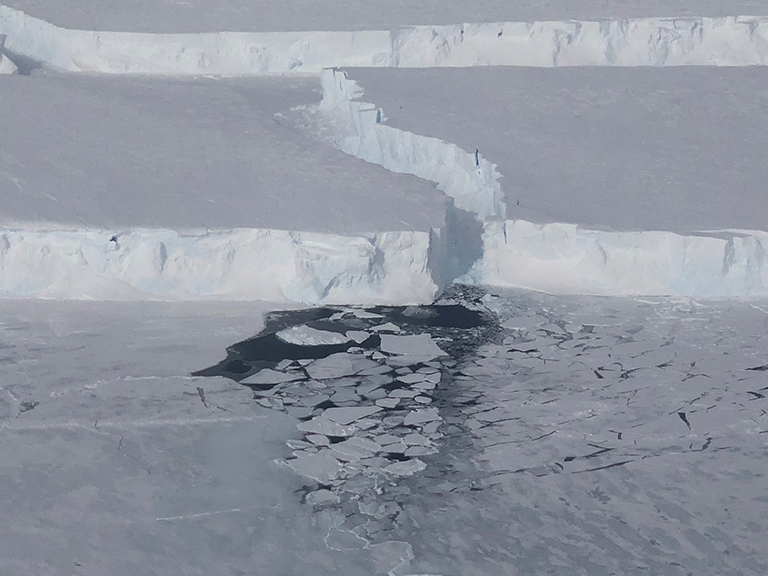
- Two glaciers in Antarctica are melting at unprecedented rates. If they collapse, global sea levels could rise by more than 10 feet (3.3 meters), swamping coastal cities like New York, Shanghai, and Calcutta.
- In a new study, scientists simulated the effect of adding artificial snow to the glaciers to stop the melt.
- While that would help, the effort would require 7.4 trillion tons of snow.
- Visit Business Insider’s homepage for more stories.
Antarctica is losing ice faster than ever in recorded history.
Two glaciers in the western part of the continent are on the verge of collapse. If these glaciers – the Pine Island and the Thwaites – destabilize, that could lead sea levels to rise by up to 10.8 feet (3.3 meters).
A group of scientists have suggested a somewhat out-there strategy that could stop western Antarctica from melting.
In a new study published in the journal Science Advances, they propose sucking water from the ocean, transporting it via pipelines to the melting portion of the glaciers, converting the water into artificial snow, then shooting the snow onto Antarctica via cannons.
This could stabilize the glaciers, the scientists calculated, if an enormous amount of snow were created. At a minimum, the effort would require 7.4 trillion tons of snow over 10 years.
Anders Levermann, a co-author of the new study, told Business Insider that this calculation shouldn't be seen as a roadmap.
"It's not really a suggestion on our part - we as scientists have to put out all possibilities to counter the problem ahead so that society can decide which to act on," he said.

Let it snow
The Thwaites and Pine Island glaciers are part of the Antarctic ice sheet, which covers at least 20,000 square miles of land (about the surface area of the United States and Mexico combined). But as ocean temperatures increase, warmer water at the base of such ice sheets is causing them to melt from underneath.
Levermann's team calculated that, to stop that destabilizing melting process, they would have to add 7.4 trillion tons of snow - at least - to a Costa-Rica sized section of the glaciers over a decade.

That undertaking would involve pumping water from the ocean at Antarctica's base up 2,100 feet to the glaciers' surface, then desalinizing it, transporting it, and blowing it out as artificial snow.
"For context, I think Big Bear's artificial snow system can make roughly 20 tons of snow per minute," Jane Flegal, a science policy expert, told Earther, referring to the California ski resort. "So to do this, some system (powered by zero-carbon energy, I'd hope) would have to run Big Bear's artificial snow-making, which is pretty serious, for 700,000 years."
An unstable Antarctic
Last year was the hottest on record for the world's oceans and the fourth-warmest for Earth overall.
The Antarctic ice sheet is melting nearly six times as fast as it did 40 years ago: In the 1980s, Antarctica lost 40 billion tons of ice annually, but that number jumped to an average of 252 billion tons per year in the last decade.
Scientists like Levermann track what's known as the glaciers' grounding lines: the point at which continental ice starts to float on water instead of sitting on the ground. The grounding line of the Thwaites glacier moved almost 9 miles inland between 1992 and 2011, according to a 2014 study; the farther it shifts, the more likely it is that the glacier will destabilize.
Already, the retreating sections of the Thwaites Glacier are contributing to 4% of sea-level rise worldwide. Another recent study found that the glacier is likely to hit a point of irreversible melting, after which it will lose all of its ice over a period of 150 years.
If just Thwaites were to melt, sea levels would rise 1.5 feet. But the loss of that glacier could trigger a chain reaction of melting across Antarctica, which could raise sea levels by another 8 feet.
That's why stopping the melt is so imperative, Levermann said.

"We've unleashed a huge beast in the south pole, and to tame it again is a tremendous effort," he added.
Pros and Cons
The obvious drawback of his team's artificial snow proposal, Levermann said, is cost.
Manufacturing the equipment needed to transport and distribute man-made snow in Antarctica would be mind-bogglingly expensive. In the study, the authors wrote that they'd need 12,000 high-powered wind turbines to power just the ocean pumps alone. And such pumps, the largest of which exists in New Orleans, cost up to $600 million each, according to Levermann.
"We would probably need 90 of those," he said.
For Levermann though, the biggest downside is that the initiative would violate the last pristine, nation-less place on Earth.
"The Antarctic Treaty says no one can step a foot onto the continent unless they're doing science, so it truly is an untouched place, without equal on the planet," he said, adding, "we're going to destroy it by doing this. This is a continent untouched by humans, and we would be making it industrial compound."
What's more, the scientists acknowledge that the snow-making endeavor could have unintended consequences. For example, generating that much snow would use up enough water to lower global sea levels by up to 2 inches over the project's decade-long lifespan. Sucking up all that water from the ocean could mess up currents and water circulation patterns.
These drawbacks pale in comparison to what would happen if the oceans rise 10 feet, though.
"Coastal cities like New York, Hong Kong, London, Calcutta, and Shanghai would be underwater," Levermann said.

When viewed through that perspective, he added, the cost of the artificial-snow idea would be nothing relative to the cost of protecting those cities from rising waters, or worse, losing them completely.

